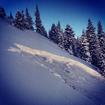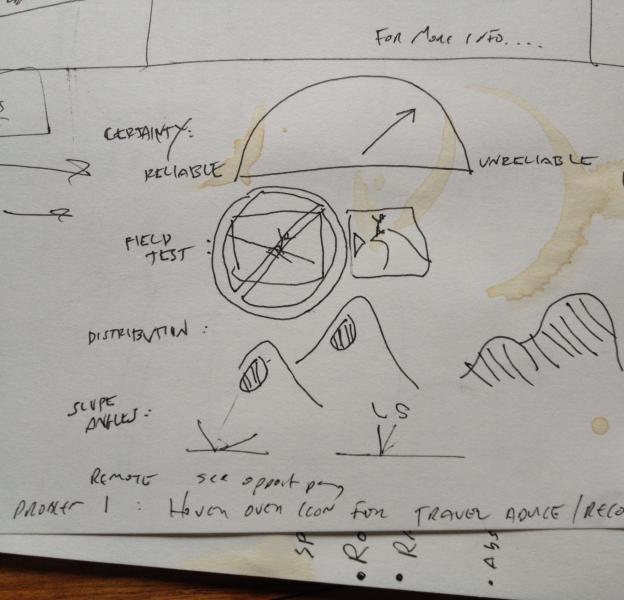
This fall, Wendy Wagner from the ChugachAvalanche Center in Alaska and I started working on travel recommendations/advice for each of the Avalanche Problems associated with the avalanche forecast. We've been querying others across the field as well as consumers of the avalanche products. I consider the Wasatch to havethe savviest and well-educated backcountry folks around - so - we'd love to have your take/feedback on the project. (feedback box below or direct - [email protected])
Our project set about to create a set of travel recommendations for the Avalanche Problems that have become the standard for avalanche forecast centers. In turn, the Avalanche Problems have become the backbone for avalanche education throughout North America. Among professionals, it is widely agreed that the avalanche conditions - that is, the overall danger as well as the particular type of avalanche one expects, determine one's choice of terrain. This is the essence of safe travel in the mountains - the Holy Grail ofmatching one's terrain to the snowpack. Many of our Tier 1 and Tier 2 users are only beginning to understand this concept; thus, we sought to create a fairly universal tool that forecast centers could use alongside the avalanche problems to assist the public in making appropriate terrain choices. Note how travel recommendations are a part of the Avalanche Danger Scale - (and if they are useful for danger ratings, they might be more useful for each avalanche problem).

We wanted the travel recommendations to be simple, useful, and easily compared based upon a parallel structure of a narrowed-down set of metrics (see below).
We divided them into two groups based upon what we'd call their inherent "manageability", or lack thereof. Manageability is well aligned with the overall degree of certainty (and again, lack thereof) of what I'd call "predictive snow behaviour". It is also aligned with user's skill/experience and overall size of the avalanche. To this end, we categorized them under Normal Caution and Extra Caution.
Normal Caution avalanche problems include
- Loose Dry
- Loose Wet
- Storm Snow
- Cornice
- Low Danger
Extra Caution avalanche problems include
- Persistent Slab
- Deep Slab
- Wet Slab
- Glide Slab
- Wind Slab
Metrics for each include
- Manageability/Certainty?
- Slope angles and terrain patterns associated with each
- Potential for remotely triggered slides and considerations for walking beneath avalanche paths
- How well are Obvious Clues to Instability noted
- InherentDangerous/destructive potential
Travel Recommendations DRAFT December 2013
Drew Hardesty, UAC Wendy Wagner, CNFAIC
Two categories – Extra Caution and Normal Caution (sample icons)
Extra Caution Normal Caution
Deep Slab Storm Slab
Persistent Slab Dry Loose Snow
Wet Slab Wet Loose Snow
Wind Slab Cornice
Glide Low Danger
********** Extra Caution
**************************************************************************************************
Deep Slab Avalanches
Unmanageable avalanche conditions associated with a high level of uncertainty. Extra Caution is advised. Test slopes, slope cuts, previous tracks, and cornice drops tend to provide little information on stability. Typically confined to particular aspects and elevations (as depicted in the current avalanche forecast). Avoid this terrain or choose slopes gentler than 30 degrees in steepness with nothing steeper above or adjacent to you. Remote triggering possible, even from the valley below. Give runout zones a wide berth. Due to potential size, traumatic injury, death, or deep burial is likely.
Glide Avalanches
Unmanageable avalanche conditions associated with a high level of uncertainty. Extra Caution is advised. Test slopes, ski cuts, previous tracks, and cornice drops often provide little information on stability. Typically confined to particular aspects and elevations (as depicted in the current forecast). Avoid this terrain or choose slopes gentler than 30 degrees in steepness with nothing steeper above. Give runout zones a wide berth. Due to potential size, traumatic injury, death, or deep burial is likely.
Persistent Slab Avalanches
Unmanageable avalanche conditions associated with a high level of uncertainty. Extra Caution is advised. Test slopes, ski cuts, previous tracks, and cornice drops often provide little information on stability. Typically confined to particular aspects and elevations (as depicted in the current avalanche forecast). Avoid this terrain or choose slopes gentler than 30 degrees in steepness with nothing steeper above. Remote triggering possible, even from the valley below. Give runout zones a wide berth.
Wet Slab Avalanches
Unmanageable avalanche conditions associated with a high level of uncertainty. Extra Caution is advised. Test slopes, ski cuts, previous tracks, and cornice drops often provide little information on stability. More prevalent on the sunlight aspects (or as depicted in the current avalanche forecast). Avoid this terrain or choose slopes gentler than 35 degrees in steepness with nothing steeper above. Remote triggering possible, even from the valley below. Give runout zones a wide berth. Due to potential size, traumatic injury, death, or deep burial is likely.
Wind Slab Avalanches
Can be manageable or unmanageable avalanche conditions associated with higher levels of certainty for experienced snow travelers. Extra Caution is advised. Test slopes, ski cuts, previous tracks, and cornice drops may provide some level of information on stability. Typically confined to particular aspects and elevations (or as depicted in the current avalanche forecast). Avoid this terrain or choose slopes gentler than 35 degrees in steepness. Give runout zones a wide berth when natural avalanches are expected or when others may be traveling above you.
********************Normal Caution
Loose Dry Avalanches
Usually manageable avalanche conditions associated with higher levels of certainty for experienced snow travelers. Normal Caution is advised. Test slopes, ski cuts, previous tracks, and cornice drops may provide some level of information on stability. More prevalent at the higher elevations on all aspects (as depicted in the current avalanche forecast). Avoid this terrain or choose slopes gentler than 40 degrees in steepness. Give runout zones a wide berth when natural avalanches are expected or when others may be traveling above you.
Loose Wet Avalanches
Usually manageable avalanche conditions associated with higher levels of certainty for experienced snow travelers. Normal Caution is advised. Test slopes, ski cuts, previous tracks, and cornice drops may provide some level of information on stability. More prevalent on the sunlight aspects (or as depicted in the current avalanche forecast). Avoid this terrain or choose slopes gentler than 40 degrees in steepness. Give runout zones a wide berth when natural avalanches are expected or when others may be traveling above you.
Storm Snow Avalanches
Usually manageable avalanche conditions associated with higher levels of certainty for experienced snow travelers. Normal Caution is advised. Test slopes, ski cuts, previous tracks, and cornice drops may provide some level of information on stability. More prevalent at the higher elevations on all aspects (as depicted in the current avalanche forecast). Avoid this terrain or choose slopes gentler than 35 degrees in steepness. Give runout zones a wide berth when natural avalanches are expected or when others may be traveling above you.
Cornice
Usually manageable avalanche conditions for experienced snow travelers. Normal Caution is advised. Prevalent along the ridgelines at the mid and higher elevations on particular aspects (as depicted in the current avalanche forecast). Cornices may release on approach. Avoid traveling along corniced ridgelines, as cornices may break back further than expected. Avoid traveling through terrain with significant cornices above. Give a wide berth when natural cornice fall is likely, when cornice fall may trigger avalanches below, or when others may be traveling above you.
Low Danger
Usually manageable avalanche conditions for backcountry recreationalists. Extra caution is warranted when traveling in exposed, steep terrain with high consequences where typically small and benign avalanches pose a significant hazard.
At this point, the idea would be to have a mouse over/pop-up window or link via a subscript 'i' to produce a window (persistent slabphoto Zach Grant)-
SAMPLE LOOK OF A POPUP WINDOW -


Other ideas would be to have different icons for each metric (manageability/certainty, reliability of tests, "habitat", etc) with a scale for each. Again, the goal is simple, useful, and intuitive. 






